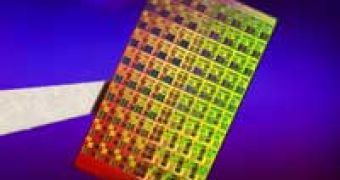The biggest problem with computer chip minimization today is that the fabrication process of semiconductor chips only allows components larger than the laser light wavelength used in the photoresist process. Any attempts to create smaller structures than the light's wavelengths will ultimately result in the use of dangerous levels of light that could destroy the chip. A new technique promising to resolve the problem once and for all has recently been proposed by an international collaboration between physicists from Texas A&M University and from Max Planck Institute for Nuclear Physics.
The method presented in the following number of Physical Review Letters involves the use of so-called dark state laser beams which presumably would be able to surpass the diffraction limit, in order to create small components. Dark state lasers imply the use of high-density beams of light, without the danger of destroying the chip.
Photoresist techniques are generally used in optical lithography, to create circuitry patterns onto semiconductor chips. The chip is being coated with a light-sensitive material, after which a specific laser pattern is being shone on the chip, which activates the light-sensitive substance that etches away the unwanted material.
However, according to theoretical physics, an exposed area of material cannot be smaller than the wavelength of light. Researchers say they can avoid damaging the chip by using high intensity laser systems, by submerging the respective chip into a liquid which will refract the light, so that eventually, patterns smaller than the wavelength can be created.
To avoid damaging the chip of the surrounding equipment, the light sensitive material could be activated through a coherent population trapping process. Without this process, the use of bright laser systems is basically inefficient, due to the fact that quantum effects prevent the light-sensitive material from becoming active. On the other hand, dark state laser systems combine a series of lower states and additional upper and lower states, plus tuned transition lasers, do not require multiphoton absorption, meaning that the laser could be kept at low intensity levels without experiencing loss in efficiency.
Suhail Zubairy says that the same outcome could be obtained by forcing the light sensitive substance into a special state, different than the dark state, by tunning different components of the low-energy laser system. In the case of multiphoton absorption, the laser beams would be split and interfere with itself, so that it would actually form an interference pattern of the photoresist substance, some strips being favored by the action of one laser or the other.
Zubairy argues that the technique proposed by his team could eventually create features on the semiconductor chip as small as half of the wavelength of light used in the process, and with optimization, maybe it could reach even a quarter of the wavelength. All that remains is for chemistry to provide with a light-sensitive substance that requires the predicted low levels of energy.

 14 DAY TRIAL //
14 DAY TRIAL //